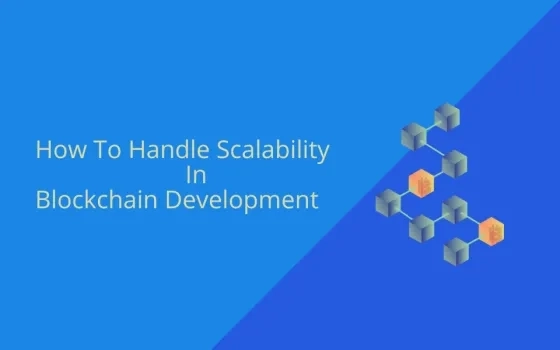Introduction Blockchain Development
Blockchain development has emerged as a transformative force in the realm of digital transactions and decentralized systems. This technology, often associated with cryptocurrencies like Bitcoin, operates on a distributed ledger system that ensures transparency, security, and immutability. As businesses increasingly adopt blockchain for diverse applications beyond finance, understanding how to handle scalability becomes crucial. Scalability in blockchain development refers to the system's ability to accommodate growing demands without compromising performance. This article delves into the fundamentals of blockchain technology and explores the significance of scalability in the context of its development.
-
Overview of Blockchain Technology
Blockchain at its core is a decentralized and distributed ledger technology that records transactions across a network of computers. It operates on a chain of blocks, each containing a list of transactions, linked together through cryptographic hashes. This structure ensures transparency and security, as altering one block would require changing all subsequent blocks, a practically impossible feat. Blockchain's decentralized nature eliminates the need for intermediaries, fostering trust in digital interactions. As blockchain technology evolves, its application extends beyond cryptocurrencies to areas like supply chain management, healthcare, and voting systems, necessitating a keen understanding of scalability for seamless development.
-
Significance of Scalability in Blockchain Development
Scalability is a pivotal aspect of blockchain development services considering the increasing demand for efficient and high-performance decentralized applications (dApps). As blockchain networks grow, handling a higher volume of transactions becomes imperative to prevent bottlenecks and maintain user satisfaction. The significance of scalability lies in ensuring that the blockchain infrastructure can scale horizontally or vertically to accommodate a growing user base without sacrificing speed or efficiency. This article explores strategies and best practices for handling scalability challenges in blockchain software development, acknowledging its critical role in the widespread adoption and success of blockchain-based solutions across various industries.
Understanding Scalability in Blockchain
Scalability is a key concept in the blockchain technology stack, defining the system's ability to handle increasing loads and transaction volumes while maintaining optimal performance. It is a critical factor for the widespread adoption of blockchain technology in various industries. Scalability ensures that a blockchain network can grow seamlessly without compromising speed, security, or decentralization.
-
Definition and Importance
Scalability in the context of blockchain refers to the system's capacity to efficiently process a growing number of transactions and accommodate an expanding user base. The importance of scalability lies in its direct impact on the performance and usability of decentralized applications (dApps) built on blockchain. A scalable blockchain can handle increased demand, ensuring that transactions are processed swiftly and the network remains responsive.
-
Factors Affecting Scalability
Several factors influence the scalability of a blockchain system. These include the consensus mechanism employed, the size of the network, the block size, and the efficiency of the underlying protocol. The choice of these elements significantly affects how well a blockchain can scale. For instance, proof-of-work (PoW) and proof-of-stake (PoS) consensus mechanisms have different scalability implications. Understanding and optimizing these factors are essential for addressing scalability challenges in blockchain development.
-
Challenges in Achieving Scalability
Achieving scalability in blockchain development is not without its challenges. One prominent issue is the trade-off between decentralization and scalability. Increasing scalability often involves compromising on decentralization, and finding the right balance is a complex task. Additionally, issues like network congestion, limited throughput, and storage constraints can hinder scalability. This section explores these challenges in detail, providing insights into the nuances of creating a scalable blockchain infrastructure that meets the demands of a rapidly evolving digital landscape.
Scalability Solutions in Blockchain
Addressing scalability challenges in blockchain development services requires innovative solutions to ensure the efficient processing of a growing number of transactions. Several strategies have been devised to enhance scalability and accommodate the increasing demand for decentralized applications (dApps). Here are some key scalability solutions:
Horizontal scaling involves adding more nodes to a blockchain network and distributing the workload across multiple machines or servers. This approach enhances the system's capacity to handle a larger volume of transactions by expanding the network horizontally rather than relying solely on the capabilities of individual nodes.
Sharding is a technique that involves dividing the blockchain network into smaller, more manageable segments called shards. Each shard processes a subset of transactions independently, improving overall throughput. Sharding is particularly effective in reducing the burden on individual nodes and enhancing the scalability of blockchain networks.
Sidechains are independent blockchains connected to the main blockchain but operate with more flexibility. They enable specific transactions or smart contracts to be processed separately from the main chain, thereby alleviating congestion and improving overall scalability. Sidechains offer a pragmatic solution to enhance the performance of the blockchain ecosystem.
Vertical scaling focuses on improving the capabilities of individual nodes within a blockchain network. This involves enhancing the processing power, memory, or storage capacity of each node to handle increased transaction loads. While not as inherently scalable as horizontal solutions, vertical scaling remains a viable option for certain blockchain architectures.
-
Optimizing Consensus Algorithms
Consensus algorithms play a pivotal role in blockchain scalability. Optimizing these algorithms, such as transitioning from proof-of-work (PoW) to proof-of-stake (PoS), can significantly enhance scalability. PoS, for instance, eliminates the energy-intensive mining process, improving the speed and efficiency of transaction validation.
-
Network and Infrastructure Upgrades
Regular upgrades to the underlying network and infrastructure are crucial for scalability. This includes optimizing communication protocols, improving data storage mechanisms, and implementing advanced cryptographic techniques. Upgrades ensure that the blockchain ecosystem evolves to meet the increasing demands of users and applications.
By incorporating these scalability solutions, blockchain developers can create more robust and responsive networks, fostering widespread adoption and utilization of decentralized technologies across diverse industries.
Layer 2 Scaling Solutions
To overcome scalability challenges in blockchain, Layer 2 scaling solutions have been developed to process transactions off the main blockchain, reducing congestion and increasing efficiency. Here are three notable Layer 2 scaling solutions:
State channels enable participants to conduct numerous off-chain transactions without involving the main blockchain for each step. By keeping most transactions off-chain, state channels enhance speed and scalability. Participants create a secure channel, execute multiple transactions privately, and only record the final state on the main blockchain development. This minimizes the computational load and increases transaction throughput, making state channels a practical solution for scalability.
Plasma is a Layer 2 scaling solution that involves creating sidechains connected to the main blockchain software development. These sidechains, known as plasma chains, process transactions independently, with the final result periodically submitted to the main chain. Plasma enhances scalability by offloading a significant portion of transactions to sidechains, reducing congestion on the main blockchain while maintaining security through periodic validation.
The Lightning Network is a Layer 2 scaling solution designed for Bitcoin and other compatible blockchains. It enables rapid and low-cost transactions by creating off-chain payment channels. Users can transact directly with each other off-chain, and only the final state is recorded on the main blockchain development. The Lightning Network enhances scalability by alleviating the burden on the main chain, allowing for quick and cost-effective microtransactions.
These Layer 2 scaling solutions showcase the ongoing efforts to optimize blockchain performance, making them more scalable and practical for a variety of use cases. Implementing these solutions helps address the limitations of on-chain transactions, fostering broader adoption of blockchain technology stack across different industries.
Optimizing Smart Contracts
In the realm of blockchain development company, optimizing smart contracts is essential for enhancing performance and reducing resource consumption. Smart contracts, self-executing code on a blockchain, are at the core of decentralized applications (dApps). This optimization involves various strategies to improve gas efficiency, code execution, and overall contract functionality.
Gas optimization is a crucial aspect of smart contract development as it directly impacts transaction costs on the blockchain. Gas refers to the computational units required to execute operations on the Ethereum network. Smart contract developers focus on minimizing gas consumption by streamlining code, reducing unnecessary computations, and utilizing more efficient algorithms, ultimately making transactions more cost-effective and environmentally sustainable.
Efficient coding practices play a pivotal role in smart contract optimization. Developers aim to write concise and well-structured code to minimize execution time and conserve resources. Code efficiency involves eliminating redundancies, optimizing loops, and adopting best practices to ensure that smart contracts perform optimally. Well-optimized code not only improves transaction speed but also contributes to a more sustainable and scalable blockchain ecosystem.
Off-chain computation is a strategy employed to reduce the computational load on the blockchain by moving certain processes off-chain. Complex computations or non-critical tasks can be performed off-chain, improving scalability and reducing transaction costs. By leveraging off-chain solutions, smart contract developers strike a balance between on-chain security and off-chain efficiency, ensuring that the blockchain remains responsive even as the complexity of decentralized applications increases.
Consensus Mechanisms and Scalability
Consensus mechanisms are fundamental to blockchain networks, influencing their scalability, security, and efficiency. Different consensus algorithms have varying impacts on a blockchain's ability to scale. Here, we explore the relationship between scalability and two prominent consensus mechanisms, Proof of Work (PoW) and Proof of Stake (PoS), as well as touch on other consensus algorithms.
-
Proof of Work (PoW) and Scalability
Proof of Work, the original consensus mechanism, involves miners solving complex mathematical puzzles to validate transactions and add blocks to blockchain development. While PoW provides security, its energy-intensive nature poses scalability challenges. The substantial computational power required for mining limits transaction throughput, making POW Blockchain Development less scalable in high-demand scenarios.
-
Proof of Stake (PoS) and Scalability
In contrast, Proof of Stake addresses scalability concerns associated with PoW. PoS selects validators to create new blocks based on their ownership or stake in the cryptocurrency. This approach eliminates the energy-intensive mining process, enhancing scalability. PoS-based blockchains typically offer faster transaction processing, reduced environmental impact, and improved scalability by enabling a higher throughput of transactions.
-
Other Consensus Algorithms
Beyond PoW and PoS, several alternative consensus algorithms aim to strike a balance between security and scalability. Delegated Proof of Stake (DPoS), Practical Byzantine Fault Tolerance (PBFT), and Directed Acyclic Graphs (DAGs) are examples. DPoS introduces a select group of nodes with voting power, enhancing scalability. PBFT prioritizes speed and efficiency, making it suitable for permissioned blockchains. DAGs, as seen in IOTA's Tangle, enable parallel transaction processing, addressing scalability challenges.
Understanding the interplay between consensus mechanisms and scalability is crucial for blockchain developers and stakeholders. Each consensus algorithm presents a unique approach to achieving consensus and balancing the trade-offs between security, decentralization, and scalability in the evolving landscape of blockchain technology.
Case Studies on Scalability Implementation
Ethereum, a pioneer in blockchain technology, is actively addressing scalability concerns through Ethereum 2.0. This ambitious upgrade introduces a shift from Proof of Work (PoW) to Proof of Stake (PoS) consensus, enhancing scalability by reducing energy consumption and improving transaction processing speed. The introduction of shard chains through Ethereum 2.0 aims to parallelize transactions, significantly increasing the network's capacity. These advancements showcase Ethereum's commitment to scalability, paving the way for a more sustainable and efficient blockchain ecosystem capable of meeting the demands of a growing user base and diverse decentralized applications.
Binance Smart Chain (BSC) has rapidly gained prominence as a scalable alternative to Ethereum. By utilizing a delegated Proof of Stake (DPoS) consensus mechanism, BSC achieves faster block times and lower transaction fees, addressing Ethereum's scalability challenges. BSC's compatibility with Ethereum's tooling and low-cost transactions have attracted developers and users alike. The success of Binance Smart Chain exemplifies how strategic design choices in consensus mechanisms and infrastructure can effectively enhance scalability, providing a competitive and user-friendly environment for decentralized applications.
Polkadot, with its unique multichain architecture, stands out as a scalability-focused blockchain solution. Designed for interoperability, Polkadot enables multiple blockchains, or parachains, to operate in parallel, boosting overall scalability. This heterogeneous sharding approach allows specialized blockchains to process transactions efficiently, addressing the limitations of a single-chain structure. Polkadot's commitment to scalability and interoperability positions it as a compelling solution for building decentralized applications that require both flexibility and efficiency in handling a large number of transactions across interconnected chains.
Best Practices for Scalable Blockchain Development
-
Planning for Scalability from the Start
A crucial best practice in scalable blockchain development is integrating scalability considerations from the project's inception. By anticipating future growth and user demands during the planning phase, developers can design a flexible and scalable architecture. This proactive approach ensures that the blockchain infrastructure can seamlessly expand, accommodating increased transaction volumes without compromising performance.
-
Regular Monitoring and Optimization
Continuous monitoring and optimization are paramount for maintaining scalability in blockchain development. Regularly assess the network's performance, identifying potential bottlenecks, and optimizing code and infrastructure. This iterative process enables developers to address scalability challenges promptly, enhancing the overall efficiency and responsiveness of the blockchain ecosystem.
-
Community and Stakeholder Engagement
Engaging with the community and stakeholders is a key best practice for scalable blockchain development services. Foster open communication channels to gather feedback, understand user needs, and address concerns. Involving the community in decision-making processes and updates promotes a sense of ownership and fosters a collaborative environment. By aligning development efforts with the expectations and requirements of stakeholders, blockchain projects can better adapt to evolving scalability needs and ensure sustained growth in a decentralized ecosystem.
Future Trends in Blockchain Scalability
The future of blockchain scalability holds promising advancements in Layer 1 innovations. These entail fundamental changes at the protocol level to enhance efficiency. Innovations such as novel consensus mechanisms, improved cryptographic techniques, and optimized data structures aim to boost the throughput of blockchain networks. By addressing scalability concerns at the core layer, these innovations aspire to lay the foundation for faster transaction processing and increased capacity, ushering in a new era of scalable and high-performance blockchain ecosystems.
Cross-chain integration is emerging as a significant trend in addressing scalability challenges. As blockchain ecosystems grow, the need for seamless communication and interoperability between different blockchains becomes crucial. Cross-chain solutions facilitate the transfer of assets and information across disparate blockchain networks, fostering collaboration and resource sharing. This trend anticipates a future where various blockchains can work together synergistically, providing a scalable and interconnected environment that can support a myriad of decentralized applications with diverse functionalities.
-
Interoperability Solutions
Interoperability solutions are poised to play a pivotal role in the future of blockchain scalability. As the blockchain space continues to diversify, achieving interoperability between different blockchain networks becomes imperative. Future trends include the development of standardized protocols and frameworks that enable smooth data and asset exchange between blockchains. Interoperability solutions aim to create a cohesive blockchain ecosystem, where various networks can collaborate seamlessly, unlocking new possibilities for scalability and expanding the scope of decentralized applications across interconnected chains.
Conclusion
Scalability stands as a paramount concept in the ever-evolving landscape of blockchain development. This journey through key scalability concepts has highlighted the diverse strategies and innovations employed to address the challenges associated with accommodating a growing user base and increasing transaction volumes. From Layer 2 scaling solutions and consensus mechanism optimizations to planning for scalability from the project's inception, the importance of scalability cannot be overstated. As blockchain technology continues to shape the future of decentralized applications, the ability to scale efficiently becomes a linchpin for widespread adoption. The adaptability, flexibility, and foresight embedded in scalable blockchain solutions will undoubtedly play a pivotal role in shaping the future of blockchain software development, fostering innovation, and meeting the dynamic demands of a global and decentralized digital economy.



















